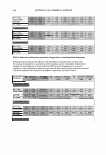334 JOURNAL OF COSMETIC SCIENCE Origin Cross-linked Trimers - Cross-linked Dimers - Monomer a1[111] _ Monomer a1 [I] _ Monomer a2[1] _ 1 1 2 2 3 3 Figure 3. SDS-polyacylamide gel electrophoresis of three collagens for cosmetic use: (1) AteloHelogen®, (2) Collasol®, and (3) CLR Collagen®. Electrophoresis can also provide a simple method to estimate the isoelectric point of the collagen preparation. Native collagens have a high pl, typically above pH 9 (24), consistent with the determined amino acid sequence data ( 17), whereas collagen that has been prepared from alkali-treated material (as a by-product of liming during leather making, for example) will have been deamidated and will have a low pl value (24). The migration of native collagen, towards anode or cathode, is an indication of its net charge at a given pH. For example (Figure 5), collagens that migrate with a net positive charge at pH 9.0 have high pl values typical of native collagens. Thus, the present data indicate that both AteloHelogen® and CLR Collagen® have the high pl values found for native, unmodified collagen, whereas Collasol® shows a low pl, such as may be found from lime-treated hide collagen. AMINO ACID ANALYSIS Amino acid analysis data are presented for the three different collagen samples (Table II). This technique is readily available through analytical service providers if it is not available in-house. These data show that all samples have the high Gly content, around one third of all amino acids, that is a characteristic of collagens. If a large amount of protein impurity is present, this value may become lower, but for most samples this type of analysis will not allow accurate determination of small quantities of impurity. These
COLLAGEN EVALUATION 335 Origin- Cross-linked Dimers - Monomers- 1 1 2 2 3 3 Figure 4. Native (lactic acid pH 3.1) polyacrylamide gel electrophoresis of three collagens for cosmetic use: (1) AteloHelogen®, (2) Collasol®, and (3) CLR Collagen®. data also show the high content in Pro and Hyp, around one fifth of all amino acids, that are essential elements of the collagen structure. The avian collagen, AteloHelogen®, which is more thermally stable (see below), shows an increased Pro and Hyp content. The amount of Tyr present shows the extent to which the telopeptides have been removed, as this amino acid is generally only found in these regions in type I collagen. However, type III collagen does contain a low level of Tyr within the helical domain (17) if analysis shows that this collagen type is present, this must be taken into account (see below). Of the three collagens examined, AteloHelogen®, which is described as monomeric, shows a very low Tyr content, despite the type III collagen shown by electrophoresis (Figure 3 ). Amino acid analysis also provides an approach to quantitation of the collagen prepara tions. These data may be obtained by using the H yp content, and relating this value to the known amount of this amino acid in the species of the collagen (17). Alternatively, the yields of all amino acids can be determined and summed. A key issue in determining collagen content is the water content that is present. Certain water molecules form an integral part of the structure and cannot be readily removed from native collagens by drying. Other water present is more loosely bound the amount of this water is depen dent on the relative humidity of the environment and so presents significant difficulties in collagen quantitation if weighing of dry samples is needed. The use of amino acid analysis allows a direct measure of the collagen content of a collagen solution.
Purchased for the exclusive use of nofirst nolast (unknown) From: SCC Media Library & Resource Center (library.scconline.org)






































































































